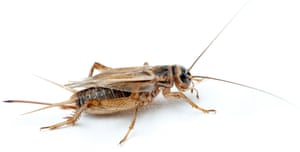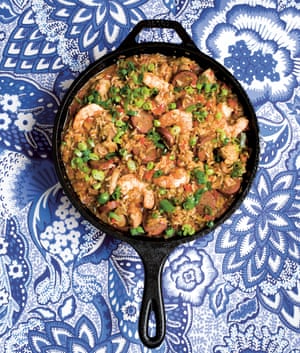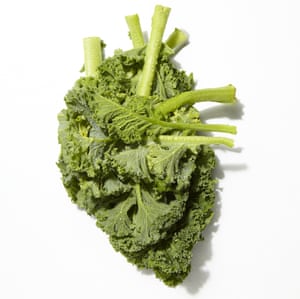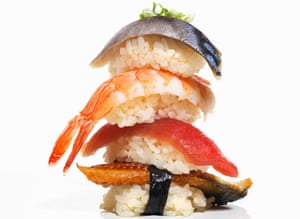Reviews, eating in public can be exposing. It is one of the few intense physical pleasures that we can enjoy with just about anyone. But when you observe someone else attack a plate of food, subtle quirks, neuroses and vulnerabilities become apparent. This is why dining with a new boss, or watching a first date devour a plate of food can be both intimidating and levelling.
I, for example, am like a barmy puppy when served meat on the bone. I pick and gnaw at it long after everyone else has finished. I’m also a fork stacker. Each mouthful must have a bit of everything on it, and, as I go, I automatically prioritise that perfect final forkful.
The chef Giorgio Locatelli is a fork stacker, too. Or at least a soup-spoon stacker. “If you have minestrone with beans in it, and you try to eat the minestrone with one bean in each spoonful, that sums it up. I like the combination of things.” He also loves getting his fingers mucky. “During the meal, I’ll go for the touch. If it can be done by hand, I will eat with my hands,” a food trait that will go down well with the never-trust-a-person-who-tackles-pizza-with-a-knife-and-fork crowd.

In a shock admission, chef Yotam Ottolenghi says he is a pernickety food compartmentaliser. You know, one of those people who ask for items to be served on the side. “I, much like my three-year-old son, like the different food items on the plate to be kept separate,” he says. “Possibly even served in a sequence and not all together. I love tasting each item and then moving on to the next one.” It seems odd that a chef could be even mildly brumotactillophobic (the impressive technical term for fear of different foods touching each other). “A typical Christmas dinner sends shivers down my spine,” Ottolenghi says. “A bunch of meats and vegetables crammed together, rendered indistinct by a uniform coating of gravy. It’s wrong!”
Brumotactillophobia is viewed by food psychologists as a hangover from childhood fussy eating. We were all picky once – even Guardian restaurant critic Marina O’Loughlin, whose mother would accuse her of performing brain surgery on meat because of her painstaking food dissection. “I refused point blank to touch even the tiniest suggestion of fat. It makes me laugh now,” she says, “on days when I’m happily scoffing lardo, or the glorious melty fat on jamón ibérico.”
Locatelli falls into a second militant eating category: the delayed gratifiers. “I always keep the special bit until last,” he says, “which is contrary to my brother. We used to have big discussions about this when we were younger. He would say that you appreciate the first mouthful more because you are hungry, so you eat the best one when you start. My logic is: no, no, you keep the best for last. I try to have a little bit of everything in the last forkful, just so I remember that flavour and texture.”
The chef Marcus Wareing, on the other hand, eats the best bit first. He has tried to equally pace his consumption of all the foods on the plate, but he cannot do it. “I just think that’s too much time wasted while the food is hot.” So his Sunday roast disappears in this order: potatoes, sage-and-onion stuffing, crackling, pork, with the poor old carrots and cauliflower left to the lukewarm end.
This debate has been studied by actual psychologists from the Ivy League University of Pennsylvania. Among Americans, delayed gratification was the more popular approach, thus supporting the psychologists’ hypothesis that Americans prefer a rising sequence in life. Only 5% gobbled the best first, à la Wareing; 35% saved the best till last, and 36% were fork stackers (go, team!).
There are, of course, external forces that dictate how we clear our plates – a subject that Julia Hormes, food behaviour expert at the University of Albany in New York, knows all too well. “I was brought up in Germany, so I’m very aware of cultural differences.” (In case you hadn’t noticed, Americans do both their cutting and their forking with one hand, often eating with their other hand in their lap.) She also points out that the acceptability of slurping or eating loudly depends on national traditions. “Slurping in Japan is good,” she says. “China considers using a knife at the table to be improper, which is why you eat with chopsticks and the knife is relegated to the realm of the kitchen.” Table manners are arbitrary. “There are rules, but they don’t necessarily make a lot of sense, and they evolved to define the upper social class and exclude the lower classes, so they had to become increasingly elaborate to identify who had access to that upper segment of society.”
I should imagine, however, that there are soppers and dunkers the world over. There is a childish delight to be had in going for the dunk, be it digestives in tea, bread in dripping or biscotti in vin santo. Or, in the case of Olly Knights from the London band Turin Brakes, Mars bars in peanut butter. “And Twixes,” he adds. “Pretty much any chocolate rigid enough. It’s finding the chocolate equivalent of a spoon, and then you want the softest peanut butter you can get your hands on.” I’m not sure Ottolenghi would approve.
And then there are those irritating people (OK, me) who think food tastes better when nicked from a loved one’s plate. The writer Howard Jacobson is also a coveter of his companion’s food. My fella and I now address this issue by swapping our restaurant meals halfway through.
Tempting as it is, you can’t read too much into people’s food traits.
The novelist Lionel Shriver brings a Marmite pot filled with chilli flakes to restaurants because she loves “skirting the line between pleasant and unpleasant”. But does this mean she likes all elements of her life to be challenging? Of course not. “I also like plain American biscuits with butter. You can’t call that challenging. There are lots of things in life that interest me but aren’t challenging.”
When it comes to food foibles, context is everything. Locatelli hates it when restaurants “show off, using some fucking stupid container, or serving food on a shovel. I adore normal plates.” Does his plate adoration mean he can’t love a paper-wrapped spleen sandwich, dripping with fat, at Palermo station? Negative.
























